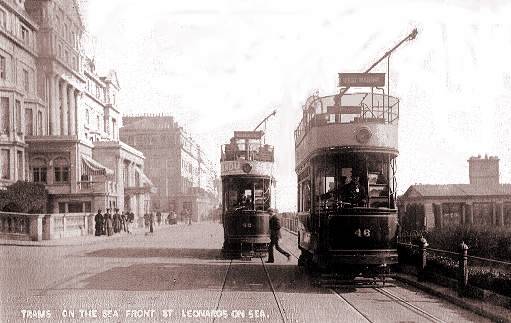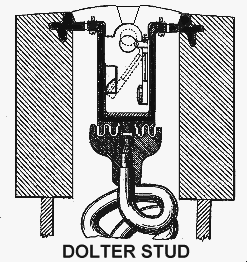

The Hastings & District Tramways Company started services in Hastings on July 31st 1905 with a tram fleet that was to expand to 65 classic open-top Preston-built cars with 5ft 6in wheelbase trucks on narrow (3ft 6in) gauge. A separate section of the tramway system, in St. Leonards and Cooden, to the west of Hastings, was opened in 1906 with its own depot and the two sections used traditional overhead wires to supply traction power. Livery was a red-maroon and cream.
The 'missing link' was a two-mile section along the Marine Parade at St. Leonards and the local council was strong in its objections to overhead wires in this elegant part of town. The link was delayed until an acceptable solution was found. The Dolter Stud System was chosen and this enabled the two parts of the tramway to be joined from January 12th 1907.
 The Dolter system of current collection, devised by Parisian Henri Dolter in 1899, powered the trams from electrified studs laid between the rails. Each tram had under its truck a 12 ft. long metal double 'skate', fitted with seven electromagnetic coils to provide the north and south poles that activated the studs as it passed over. Each stud had a twelve by seven inches in size manganese steel head and had an oil insulated ceramic cylinder below containing the switchgear. This consisted of an inverted 'L' shaped lever pivoted at the heel, with a soft iron armature at the top and carbon contacts at the bottom sides, which completed the electrical circuit when the armature was attracted upwards by the magnetic skate. At 9 ft. intervals, the studs were sufficiently close together to ensure that the skate was always in contact with at least one stud. When the tram had passed, gravity allowed the armature to drop back and deactivate the stud. Although fine in theory and despite a wire brush safety device on the cars which shorted out live studs blowing a fuse in them and raising an alarm bell on the car, it was not uncommon for studs to remain live, thus posing a serious risk of electrocution to man and beast.
The Dolter system of current collection, devised by Parisian Henri Dolter in 1899, powered the trams from electrified studs laid between the rails. Each tram had under its truck a 12 ft. long metal double 'skate', fitted with seven electromagnetic coils to provide the north and south poles that activated the studs as it passed over. Each stud had a twelve by seven inches in size manganese steel head and had an oil insulated ceramic cylinder below containing the switchgear. This consisted of an inverted 'L' shaped lever pivoted at the heel, with a soft iron armature at the top and carbon contacts at the bottom sides, which completed the electrical circuit when the armature was attracted upwards by the magnetic skate. At 9 ft. intervals, the studs were sufficiently close together to ensure that the skate was always in contact with at least one stud. When the tram had passed, gravity allowed the armature to drop back and deactivate the stud. Although fine in theory and despite a wire brush safety device on the cars which shorted out live studs blowing a fuse in them and raising an alarm bell on the car, it was not uncommon for studs to remain live, thus posing a serious risk of electrocution to man and beast.
The real photographic postcard by an unknown publisher and posted in August 1907 shows the safety solution with car 42 on the left trailing from its bumper the 'short-circuiting brush'. Car 46 is bound for West Marina and car 42 is on the return journey to Hastings Memorial. These two trams and indeed all the cars equipped for stud working, were built by the United Electric Car Co. Ltd. Cars 41 to 60 were fitted for Dolter Stud/Trolley dual working and had a changeover switch used by the motorman. Salt water from rough seas was not kind to the stud working mechanisms. At night, the Dolter system was often spectacular in operation with brilliant arcing reminiscent of heavy gunfire thus giving the cars a nickname of 'Front Line Trams'. After World War I, the Board of Trade requested the removal of the studs and in 1913 services were replaced by having some of the trams fitted with petrol-electric motors. By 1921 and after further representation to St. Leonards Council, traction poles and overhead wires were installed.
The Dolter stud system was also used in Paris (1902-1910), Mexborough (1907-08) and Torquay - see Postcard (1907-11) .
The last Hastings tram ran on May 15th 1929 by which time most of the tram routes were replaced by trolleybuses which continued to serve the town until 31st May 1959.
![]() Go to Postcard Of The Month Index
Go to Postcard Of The Month Index